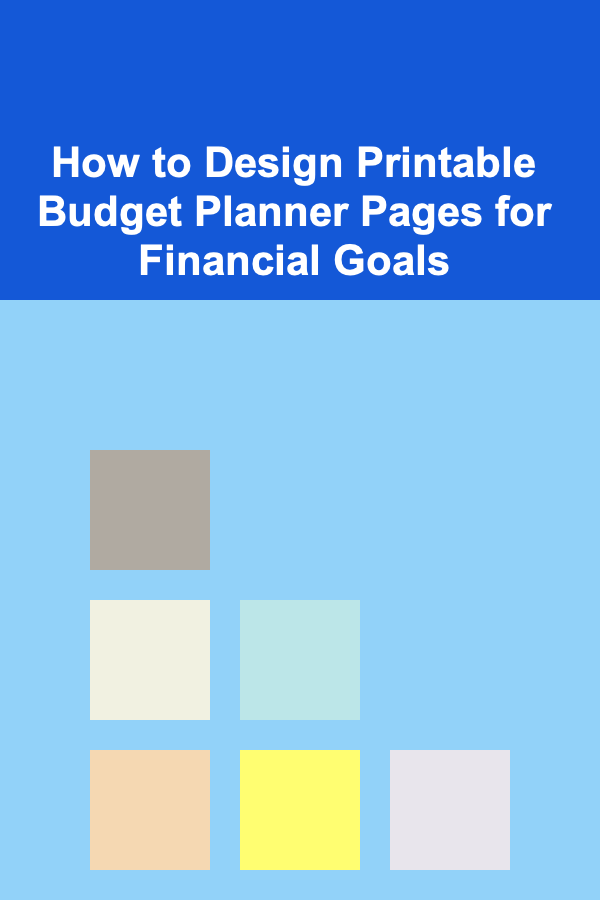
How to Design Printable Budget Planner Pages for Financial Goals
ebook include PDF & Audio bundle (Micro Guide)
$12.99$11.99
Limited Time Offer! Order within the next:

Managing personal finances is a critical skill for individuals seeking to maintain financial health, save for future goals, and navigate daily spending. One of the most effective ways to manage finances is through the use of a budget planner, which allows individuals to track income, expenses, savings, and investments. A well-designed printable budget planner can make this process simpler, more organized, and more motivating. In this article, we will explore how to design effective and user-friendly printable budget planner pages for financial goals.
Understanding the Importance of Budgeting
Before diving into the design process, it's essential to understand the significance of budgeting. Budgeting is a financial tool that helps individuals allocate their income toward necessary expenses, savings, and discretionary spending. It provides a clear picture of one's financial situation and helps prevent overspending, saving for emergencies, and reaching specific financial goals.
A good budget planner can:
- Track spending habits: Identify areas where money is spent unnecessarily.
- Set financial goals: Allow individuals to set short-term and long-term financial goals, such as saving for a vacation or purchasing a home.
- Promote saving: Encourage individuals to allocate a portion of their income toward savings or investments.
- Reduce financial stress: Help individuals take control of their finances and reduce anxiety about money.
Given these advantages, designing an efficient, visually appealing, and easy-to-use printable budget planner can significantly help individuals with their financial planning.
Key Components of a Printable Budget Planner
A well-designed printable budget planner should have specific sections that allow users to organize their finances effectively. Below are the key components that should be included:
1. Monthly Overview
The monthly overview is a crucial part of the budget planner. It provides a snapshot of the entire month, allowing users to plan their income and expenses, and set goals.
- Income Section: This section should include a space to track various sources of income, such as salary, freelance work, or investments.
- Fixed Expenses: Fixed expenses are regular, predictable costs, such as rent, mortgage payments, insurance premiums, and utilities.
- Variable Expenses: Variable expenses may fluctuate each month, including groceries, entertainment, and transportation.
- Savings Goals: Include a space to allocate a set amount for savings, whether for emergencies, a vacation, or retirement.
- Debt Repayment: For individuals with debt, this section should allow them to track monthly payments toward credit cards, student loans, or other obligations.
By clearly separating income and expenses, users can get a clear view of their financial situation each month.
2. Expense Tracker
An expense tracker is an essential part of any budget planner. It helps individuals track their daily or weekly expenses and ensures they stay within budget.
- Date: Include a section for the date of each expense.
- Category: Categorize expenses, such as groceries, dining out, entertainment, and transportation. This allows individuals to identify areas where they may be overspending.
- Amount: Record the amount spent for each category.
- Payment Method: Track whether expenses were paid via cash, credit card, or debit card.
Having a space to track expenses regularly helps individuals stay accountable to their budget and make adjustments as needed.
3. Savings Goals Tracker
Saving for specific goals---whether it's an emergency fund, a vacation, or a down payment for a house---is a critical aspect of financial planning. A savings goal tracker should allow individuals to break down their savings objectives into achievable milestones.
- Goal Description: List the specific savings goal, such as "Vacation Fund" or "Car Repair Fund."
- Target Amount: Specify the total amount needed to achieve the goal.
- Progress Tracker: Include a section where users can track how much they've saved so far toward each goal. This can be a visual tracker, such as a bar or pie chart, to make progress more tangible and motivating.
- Monthly Contributions: Indicate how much the individual plans to contribute each month to reach their savings goal.
This section keeps users motivated to reach their goals while also providing clear milestones for success.
4. Debt Tracker
For many people, managing and reducing debt is a primary financial goal. A debt tracker helps individuals organize and plan for paying off outstanding debts.
- Debt Description: List each debt, such as credit card balances, student loans, or personal loans.
- Total Balance: Record the outstanding balance for each debt.
- Minimum Payment: Include the minimum monthly payment due for each debt.
- Interest Rate: Track the interest rate to prioritize higher-interest debts.
- Progress Tracker: Like the savings goals tracker, include a progress section to monitor how much debt has been paid off.
By providing an overview of all debts and a strategy for repayment, individuals can work toward becoming debt-free.
5. Weekly or Daily Budget Breakdown
Some individuals prefer breaking down their budget on a smaller scale, such as weekly or daily. This helps them stay on track with smaller amounts and make adjustments more frequently.
- Weekly Expenses: Create a weekly budget section where users can allocate specific amounts for each category.
- Daily Expenses: For those who prefer tracking on a daily basis, design a section where users can record expenses each day.
- Spending Limits: Include recommended spending limits for categories like dining out, entertainment, and transportation, based on the monthly budget.
A weekly or daily breakdown can help users avoid overspending between paychecks and ensure that they are consistently adhering to their budget.
6. Visual Budget Planner
While not absolutely necessary, incorporating visual elements into the budget planner can help users engage more with the process. These elements can include:
- Charts and Graphs: Visual representations of income, expenses, savings goals, and debt repayment can make complex financial data easier to digest.
- Color Coding: Use color coding to differentiate between categories, such as green for savings, red for debt, and blue for income.
- Motivational Quotes: Include inspiring quotes related to money management or financial success to keep users motivated.
Visual aids help make the process of budgeting more engaging and can enhance the user's ability to grasp their financial situation at a glance.
Tips for Designing a Printable Budget Planner
1. Simplicity and Clarity
When designing a printable budget planner, the layout should be clear and easy to understand. Avoid cluttering the pages with too many sections or overly complex formats. Use simple fonts and design elements to ensure the planner is user-friendly.
2. Customization
Allow for flexibility so that users can tailor the planner to their unique financial situation. Include blank spaces where they can add their own categories or goals. This customization will make the planner more personal and effective.
3. Consistency in Design
Maintain consistency in fonts, colors, and spacing throughout the planner. This creates a cohesive, professional look and ensures the planner is easy to follow. For example, use the same font for headings and a different one for body text to establish a clear hierarchy.
4. Print-Friendly Design
Since the planner is printable, ensure that it is designed to fit standard paper sizes (e.g., 8.5 x 11 inches in the US or A4 in many other countries). Leave margins for easy printing, and avoid overly complex layouts that may not print well on home printers.
5. Space for Notes
Include a section for notes where users can write down reminders, additional financial goals, or reflections about their budgeting journey. This makes the planner more interactive and helps individuals stay organized.
Conclusion
Designing printable budget planner pages is an excellent way to help individuals take control of their finances and achieve their financial goals. By focusing on key components such as income tracking, expense monitoring, savings goals, and debt repayment, and incorporating visual elements and customization options, a well-designed budget planner can provide the structure and motivation necessary for successful money management. Whether you're a beginner or experienced in personal finance, a printable budget planner is an essential tool to create and maintain financial stability.
By designing a planner that is simple, customizable, and visually engaging, you can empower individuals to take charge of their financial journey and reach their goals with confidence.
Reading More From Our Other Websites
- [Personal Investment 101] Making Money from AI: How to Monetize Deep Learning Models
- [Home Maintenance 101] How to Remove Wallpaper Like a Pro: A Step-by-Step Guide
- [Gardening 101] Designing a Low‑Maintenance Native Plant Garden: A Step‑by‑Step Guide
- [Toy Making Tip 101] Step-by-Step Tutorial: Crafting Your First Wooden Toy in One Weekend
- [Scrapbooking Tip 101] How to Turn Everyday Polaroids into Stunning Scrapbook Pages
- [Home Holiday Decoration 101] How to Upcycle Old Jars into Beautiful Holiday Candle Holders for Your Dining Table
- [Organization Tip 101] How to Organize Your Closet by Season for Easy Access
- [Ziplining Tip 101] Safety First: What to Expect on a High-Altitude Zipline Experience
- [Home Budget Decorating 101] How to Use Lighting to Enhance Your Home's Decor Without Breaking the Bank
- [Home Maintenance 101] How to Properly Vent Your Kitchen Appliances

Affordable Options for Home Security Systems: Keeping Your Home Safe on a Budget
Read More
How to Manage Your Pet's Health with Regular Home Checkups
Read More
How to Organize Important Papers and Documents in Your Bedroom
Read More
How to Save for Large Purchases Without Taking on Debt
Read More
Law and Justice: Understanding the Legal System and Its Impact on Society
Read More
How to Understand the Principles of Adaptive Optics
Read MoreOther Products

Affordable Options for Home Security Systems: Keeping Your Home Safe on a Budget
Read More
How to Manage Your Pet's Health with Regular Home Checkups
Read More
How to Organize Important Papers and Documents in Your Bedroom
Read More
How to Save for Large Purchases Without Taking on Debt
Read More
Law and Justice: Understanding the Legal System and Its Impact on Society
Read More